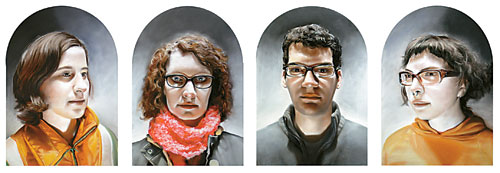chpac-staff AT lists.ibiblio.org
Subject: Chpac-staff mailing list
List archive
- From: "Steve Wright" <swright AT townofchapelhill.org>
- To: <chpac-staff AT lists.ibiblio.org>
- Subject: [Chpac-staff] Town Hall review
- Date: Thu, 17 Jan 2008 12:10:15 -0500
|
Dear CHPAC, Erica also points out a review of the current Town Hall show
in the Independently Weekly article linked and reproduced below. -Steve From: erica rothman
[mailto:erothman AT mindspring.com] did you see Amy White's article in the Independent of the Town Hall
exhibit? It's terrific! POSTED ON JANUARY 16, 2008: Municipal art worth seeing at Works by Troy Wingard, Una Pett, James B. Ward Sometimes
it's worth taking the time to go out and see actual art. In some cases there is
a payoff. The thumbnail image on your computer screen or the pixilated
reproduction in your newspaper doesn't always pack the same punch as in that
moment when a real live art piece enters your visual field. You might
want to consider dropping by With
"Doug," Wingard posits portraiture as landscape. This has something
to do with scale. The outsized drawing emphasizes the planes of the face as
mappable expanse. The subject's _expression_ sets forth a feeling of a
"place" of contemplation, process, thought, intention. It's a
fleeting moment that's also infinitely complex and absorbing. It is difficult
to view this work for any amount of time without an involuntary empathic shift
into a shared state of being with the drawing's subject. Wingard's
"Freedom Icon" depicts a young man rendered in black and white. He
wears glasses, a cap, dreads. He looks outward. His head is encircled by a
metallic gold halo. If there were any question as to whether Wingard strives
for an almost religious, spiritual statement, "Freedom Icon" puts
that question to rest. While the iconography of the halo may scan as
heavy-handed, one has to appreciate Wingard's bold inference. Wingard bears
witness to the sacred in the mundane, and for him this means seeing divinity in
people he knows.
Another
overt take on religious art is "For Posterity," which features four
beatific figures, each set off by an arch. They are young people, pale, awake,
with a gleam in their eyes. They are dressed in contemporary casual clothes:
orange zip-up vest, leather jacket, a hoodie, fashionable glasses. One figure
sports a nose ring. Wingard draws his friends as he sees them, scruffy saints
set against a stormy grey backdrop. In the
title "But What is Your Intent?" Wingard echoes the kinds of
questions put to art school students. This subtle two-part composition sets
forth an upper arch that frames the torso of the artist, hands open to reveal
fingers, thumbs, palms covered with pastel dust. The lower section features two
figures: one in a green T-shirt who wanders off, while the other is seen in
close-up, his eyes trained downward through glasses toward an unseen
light-source, inquisitive. His face is soft, mouth a bit slack. The quality of
this particular gaze at this particular moment is the focal point of the piece.
Informed by photography and perhaps even Photoshop, Wingard's imagery reflects
contemporary technologies in an ancient medium. The beauty of Wingard's work is
in his capacity to transcend his own mastery of the medium. That is the mandate
of virtuosity; once it is achieved it becomes a given. It is then up to the practitioner
to determine how to put it to use. That is something art school cannot teach. Unfortunately,
the Town Hall show is hung in such a way that Wingard's work is interspersed
throughout the building with work by another artist, Una Pett. This random,
hodgepodge presentation diminishes the power of both artists' work, and much is
lost in this curatorial approach.
Pett is
an accomplished, competent portrait artist. The work on display highlights her
preoccupation with the geometry of portraiture—she takes an architect's
approach to the depiction of the face. The graphite pieces have the quality of
architectural blueprints. Breaking the pictorial plane into an agglomeration of
surfaces, Pett employs precise cross-hatching and an assured hand in her
drawing. She also works with erasure as a mode of construction. "jane"
(all Pett's titles are in lowercase) is done in graphite, water color and
gouache on paper. In this piece, paint is applied with economy, highlighting
the outline of a figure rendered primarily in pencil. The drawing's subject is
seen reclining, reading. Pett's composition is paradoxical; its active,
gestural markings coalesce to convey a figure in repose. Pett's
"conversation" series consists of long narrow drawings, studies of
rows of standing figures seen mainly from behind. "conversation III"
is perhaps the most successful. Rendered against a gray-green background, the
drawing comes alive with the painterly, visible brush strokes that form the
negative space in monochrome, vibrantly setting off her figure studies. Many of
Pett's pieces are formal studies of heads that bear names of people who are
close to her. These are well-worked, considered canvases. However, many of them
feel more like perfectionistic studies than fully realized paintings. One
exception is from Pett's "lou" series. "lou I" is Pett's
smallest scale offering in the show, but it is the most fully realized. Its
simplified palette and deft composition gives this diminutive work aesthetic
weight.
Rounding
out the exhibit are elegant examples of wheel-thrown and altered stoneware by
James B. Ward. These are simple utilitarian pieces: bowls, plates, cups and
teapots. Ward's glazes are subtle, rich earth tones. The works are humble in
the best sense. They hold the space with grace and generate a renewed
excitement about the idea of the handmade. Chapel Hill Town Hall, located at 405 Martin Luther King Jr.
Blvd., is open Monday to Friday from 9 a.m.to 5 p.m. For more information, call
968-2749 or e-mail info AT chapelhillarts.org. |
- [Chpac-staff] Town Hall review, Steve Wright, 01/17/2008
Archive powered by MHonArc 2.6.24.


